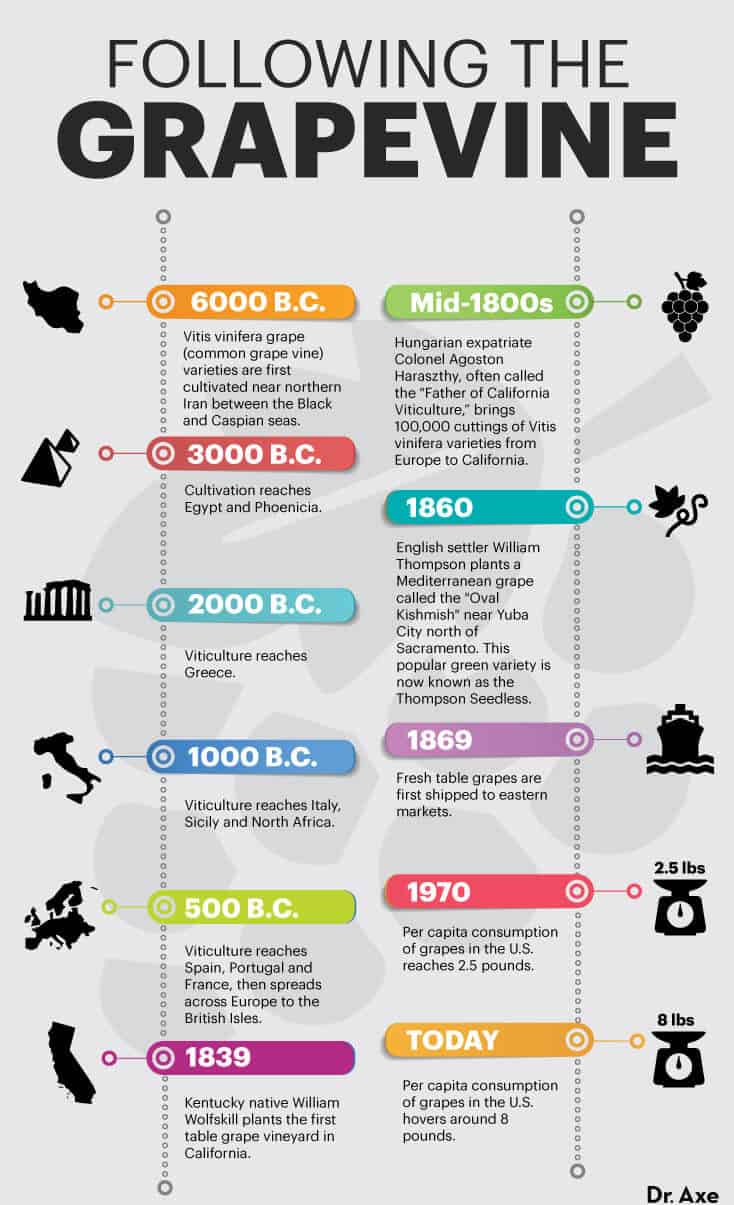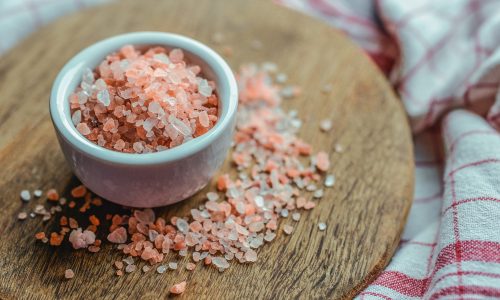
How Grapes Nutrition Helps Boost Health, Including Your Brain
Dr. Josh Axe, DC, DMN, CNS – We all know how delicious and versatile grapes are — used to make wine, raisins and grapeseed oil, among other grape products.
Grapes are so much fun to eat with their round shape and unique texture — not to mention their sweetness combined with a bit of tart flavor. What are some benefits of eating grapes?
These delicious fruits has been shown to potentially help extend life, reduce obesity and diabetes risk, and may even help prevent cancer. Plus, grapes can boost your brain and heart health, among many other remarkable benefits of grapes nutrition.
This makes them great to add to salads, have as a snack between meals and enjoy as frozen treats.
Benefits of Grapes
Grapes grow on a grapevine (Vitis vinifera) and belong to the family Vitaceae, which comprises about 60 inter-fertile wild Vitis species found throughout Asia, North America and Europe under subtropical, Mediterranean and continental–temperate climatic conditions.
Considered a part of the berry family, you can find some grapes with edible seeds while others are seedless. Similar to blueberries, grapes are often covered by a protective, whitish bloom.
For thousands of years, grapevines have been vastly used for cultivation of fruit, juice, jams and wine.
Why are grapes a healthy snack? They can make a good daily addition to your diet since they’re a good source of nutrients, including antioxidants, fiber, vitamin K and vitamin C.
Here’s more about some of the many benefits of grapes:
1. Support Longevity
Who doesn’t want to eat foods that will help them have a longer, healthier life? Well, the classic grape may be one of those amazing foods due to the phytonutrients found within them.
Resveratrol, which is a stilbene phytonutrient mostly found in the skins but also found in the seeds and flesh, has been shown to increase expression of three genes all related to longevity.
Studies indicate that resveratrol content varies significantly with genetic background, but generally, resveratrol totals are lower in the leaves than the skins. That means the skin is responsible for a great deal of grapes nutrition benefits, particularly helping extend life.
In fact, some of the longest-living cultures, like those in the blue zones, include grapes in their diets.
2. May Help Reduce Obesity and Type 2 Diabetes
Metabolic syndrome, related diseases and obesity are the most prevalent nutrition-related issues in the U.S. Evidence suggests that polyphenols in grapes and grape products may reduce metabolic syndrome and prevent development of obesity and type 2 diabetes by acting as multi-target modulators with antioxidant and inflammation-reducing effects.
Grapes have been classified as a low glycemic index (GI) food, with GI values ranging between 43–53. However, having a low GI value is not necessarily the same as having blood sugar benefits.
Recent studies have shown that grapes, grape juices and grape extracts, due to the amazing phytonutrients found in them, may offer better blood sugar balance, better insulin regulation and increased insulin sensitivity.
Freeze-dried grape powder and grape powder extracts, obtained from red, green and blue-purple seeded and seedless California grapes, were testedfor their effects on glucose tolerance and inflammation and showed improved glucose tolerance and reduced inflammation. In addition, grape seed extract may prevent metabolic syndrome, type 2 diabetes and obesity while improving gut health.
3. Loaded with Antioxidants
Flavonoids found in grapes represent high-antioxidant properties that help reduce oxidative stress. It’s reported that flavonoids, as a result of their metabolic conversion in the human body, may generate large amounts of simple phenolic acids, which have significant effects in scavenging free radicals and improving the action of other antioxidants.
Vitamin C and manganese are two important nutrients to note, particularly given that grapes are some of the highest-concentration vitamin C foodsaround. Grapes also are filled with antioxidant phytonutrients that range from common carotenoids, like beta-carotene, to unusual stilbenes like resveratrol.
In fact, the number of different antioxidant nutrients in grapes would take a while to list. Although the entire grape is useful to our bodies, the seed and the skin contain the richest concentration of antioxidants.
Because of this, most research has been conducted on grape skin, grape skin extract, grape seed, grape seed extract, or on grape extracts that contain skin, seed and flesh. The flesh of the grape contains approximately 1/20th–1/100th of the total antioxidant capacity of the seed or the skin.
4. Possess Anti-Inflammatory Action
Grapes nutrition polyphenols have been shown to decrease chronic inflammation. As natural compounds, grape flavonoids and proanthocyanidins can target multiple pathways to overcome chronic inflammation and may be more effective than synthetic drugs.
5. Help Keep Your Cardiovascular System in Good Shape
The list of cardiovascular benefits provided by grapes is pretty amazing. Several studies have shown that consumption of grape products may have beneficial effects on the cardiovascular system by:
- enhancing endothelial function
- decreasing LDL oxidation
- improving vascular function
- altering blood lipids and cholesterol levels
- regulating blood pressure
- and modulating inflammatory processes
6. May Help Prevent Cancer
Another special benefit of grape consumption is aiding cancer prevention. The rich supply of antioxidants provided by grapes nutrition can help us avoid the dangerous combination of free radical damage and chronic inflammation, making this fruit a tremendous cancer-fighting food.
Fiber is greatly needed for a healthy colon, and grapes provide us with approximately one gram of fiber in every 60 calories. This antioxidant-fiber combination may be one of the reasons that colon cancer prevention has become more prevalent in health research on grapes.
In fact, in one study it was found that natural grape extracts regulate colon cancer cells’ malignancy.
Researchers have also found that grape skin extract possesses positive chemotherapeutic results against breast cancer. And let’s not forget about raisins, which have been noted for their effects on human colon cancer cells and pancreatic cancer cells due to their antioxidant properties.
7. Better Brain Function
Studies suggest that the consumption of flavonoid-rich grape products may have a significant beneficial effect on brain function and the central nervous system.
Grape flavonoids, specifically anthocyanins, may help to prevent neurodegenerative processes both by inhibition of neuro-inflammation and by reducing oxidative stress.
A clinical study demonstrated that 12 weeks of supplementation with purple grape juice in the diet may have neurocognitive benefits in older adults with early memory decline. Consumption of grape juice was also found to improve memory functions in older adults with mild memory decline, possibly helping work as an Alzheimer’s natural treatment.
8. Antimicrobial Benefits
Numerous grape phytonutrients have been shown to have antimicrobial properties, due to the presence of phytonutrients that range from common flavonoids like quercetin, to less common stilbenes like piceatannol and resveratrol.
While more studies need to be conducted, researchers think that they may be able to help us prevent microbe-related problems like food-borne illness.
Grape juice, skin and seed extracts from table grapes have been found to have a strong inhibitory effect against the growth of some bacteria. Alcohol-free red and white wine extracts have been shown to have moderate antifungal activities on Candida albicans.
This antifungal activity of grape products has made them attractive for commercial applications, such as skin care products. And the grape flavonoids may play an important role in a healthy gut, ultimately providing beneficial effects in control of weight loss.
Grapes Nutrition Facts (Plus Types)
One cup (approximately 151 grams) of grapes contains about:
- 104 calories
- 27.3 grams carbohydrates
- 1.1 grams protein
- 0.2 gram fat
- 1.4 grams fiber
- 22 micrograms vitamin K (28 percent DV)
- 16.3 milligrams vitamin C (27 percent DV)
- 0.2 milligram copper (10 percent DV)
- 288 milligrams potassium (8 percent DV)
- 0.1 milligram thiamine (7 percent DV)
- 0.1 milligram riboflavin (6 percent DV)
- 0.1 milligram vitamin B6 (6 percent DV)
- 0.1 milligram manganese (5 percent DV)
Don’t let their small size fool you. As noted earlier in this article, even one cup of grape contains a ton of phytonutrients.
A single grape variety most likely contains some, but not all, of the phytonutrients listed below:
- Stilbenes — resveratrol, piceatannol, pterostilbene
- Flavanols — catechins, epicatechins, procyanidins, proanthocyanidins, viniferones
- Flavonols — quercetin, kaempferol, myricetin, isorhamnetin
- Phenolic acids — caffeic acid, coumaric acid, ferulic acid, gallic acid
- Carotenoids — beta-carotene, lutein, zeaxanthin
Types
Table, wine and raisin grapes come from the same family of plant, but there are about 60 different species. Within these 60 species, there are literally thousands of grape varieties.
If you have ever tried to study the origin of wine in various countries, you see that much if it has to do with the region in which grapes are grown. Italy alone has more than 1,000 varieties of wine grapes in its hillside vineyards!
- Larger grapes that are eaten as is are typically called table grapes, while smaller wine grapes that are found in vineyards are the type used to make wine. Table grape varieties are most often plumper and are usually found seedless. They have relatively thin skins, making them more pleasant to eat than the wine grape due to being less bitter.
- Raisin grapes are grapes that are typically dried by the sun, whether on paper trays or dried on the vine, so they become the dried fruit known as the popular kid-favorite raisin.
- Wine grapes are usually smaller in size, contain seeds and have relatively thick skins. While the thicker skin may be more bitter, one benefit is that it helps provide the wine with a richer aroma. Turning grapes into wine also promotes the biosynthesis and metabolism of grape volatile compounds, which can have a range of protective effects.
Which type is better, red or green?
All types of grapes come in a variety of colors. While red, black and green grapes are the most commonly consumed color varieties in the U.S., other types include amber/yellow, blue-black, crimson, pink and purple. White grapes may be a term that you’re familiar with, but they’re actually green in color.
Some research suggests that green grapes seem to be a bit lower in flavonoids than red grapes, which have skins that are richer in certain beneficial compounds, including resveratrol. However, all colors of grapes have still been found to contain a variety of protective compounds, such as:
- caffeic acid
- catechin gallate
- epicatechic
- gallic acid
- protocatechuic acid
- and rutin
Because red grape skins ferment for longer to create red wine, red wine is thought to be especially rich in resveratrol.
Grapeseed oil is another notable form of the grape because it’s high in polyunsaturated fatty acid omega-6s, especially linoleic acids. It’s also a good source of vitamin E and great as a moisturizer for hair and skin.

Recipes
In order to get everything grapes nutrition has to offer, you can add this fruit to a variety of dishes, such as salads, shakes and cheese platters. Here are some healthy recipes to give you inspiration:
Related: Cucamelon: How to Grow Instagram’s Most Popular Superfood
Risks and Side Effects
Are grapes ever bad for you? One concern is that they may contain a high level of pesticides if grown conventionally.
The Environmental Working Group has frequently identified conventionally grown grapes as one of most problematic fruits and vegetables in terms of pesticide residues.
By purchasing certified organic grapes, you can avoid the damaging intake of pesticides.
In a recent study of 99 vineyards in the Aegean Sea area of the Mediterranean, pesticide residues were found on conventionally grown table grapes but were determined to be undetectable on grapes that had been organically grown. This is great news and provides the evidence needed that going organic is a must.
To keep your sugar intake in check, try sticking to about one cup per day. Ideally, pair grapes with a source of protein and/or fat to make them more satiating.
Are seedless grapes genetically modified?
Many think that if a grape is seedless, it has been genetically modified. Of course, GMO grapes should be avoided, but seedless does not mean they’ve been genetically engineered.
Some seedless varieties of grapes are the result of natural mutations, and these varieties can be vegetatively propagated to allow for commercial production.
Other grape varieties produce seedless fruit if pollination is withheld while some can be produced by crossbreeding or grafting. None of these methods involve direct manipulation of the grape plants’ genetic material, keeping most of grapes nutrition intact. But like most foods, certified organic versionsare best to ensure that you’re not consuming GMOs.
Conclusion
- While there are relatively few calories in grapes, they are a good source of many antioxidants, vitamins C and K, plus fiber and other nutrients.
- Grapes nutrition can provide benefits such as helping reduce obesity, type 2 diabetes, high blood pressure and cholesterol, and promoting healthy digestion, brain function and more.
- Which grapes are better, red or green? Red grapes get their color from disease fighting antioxidants called flavonoids, so this type is favored by most health experts. However, all types still provide nutrients.
To read the original article click here.
For more articles by Dr. Axe click here.






